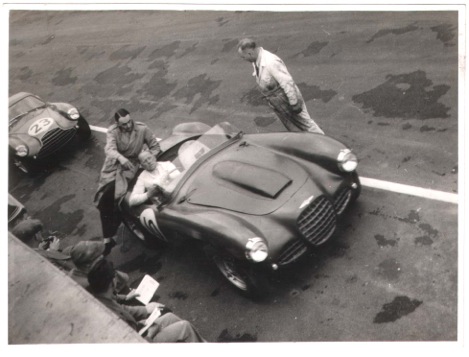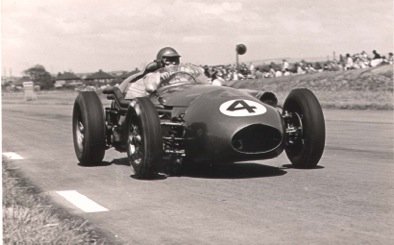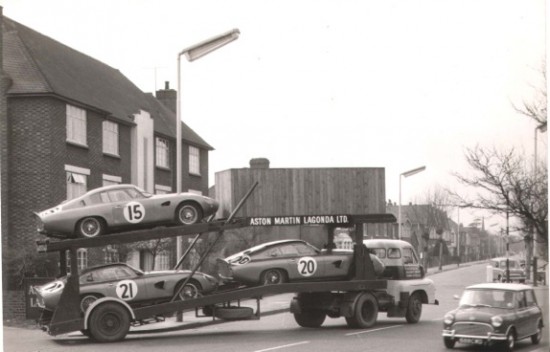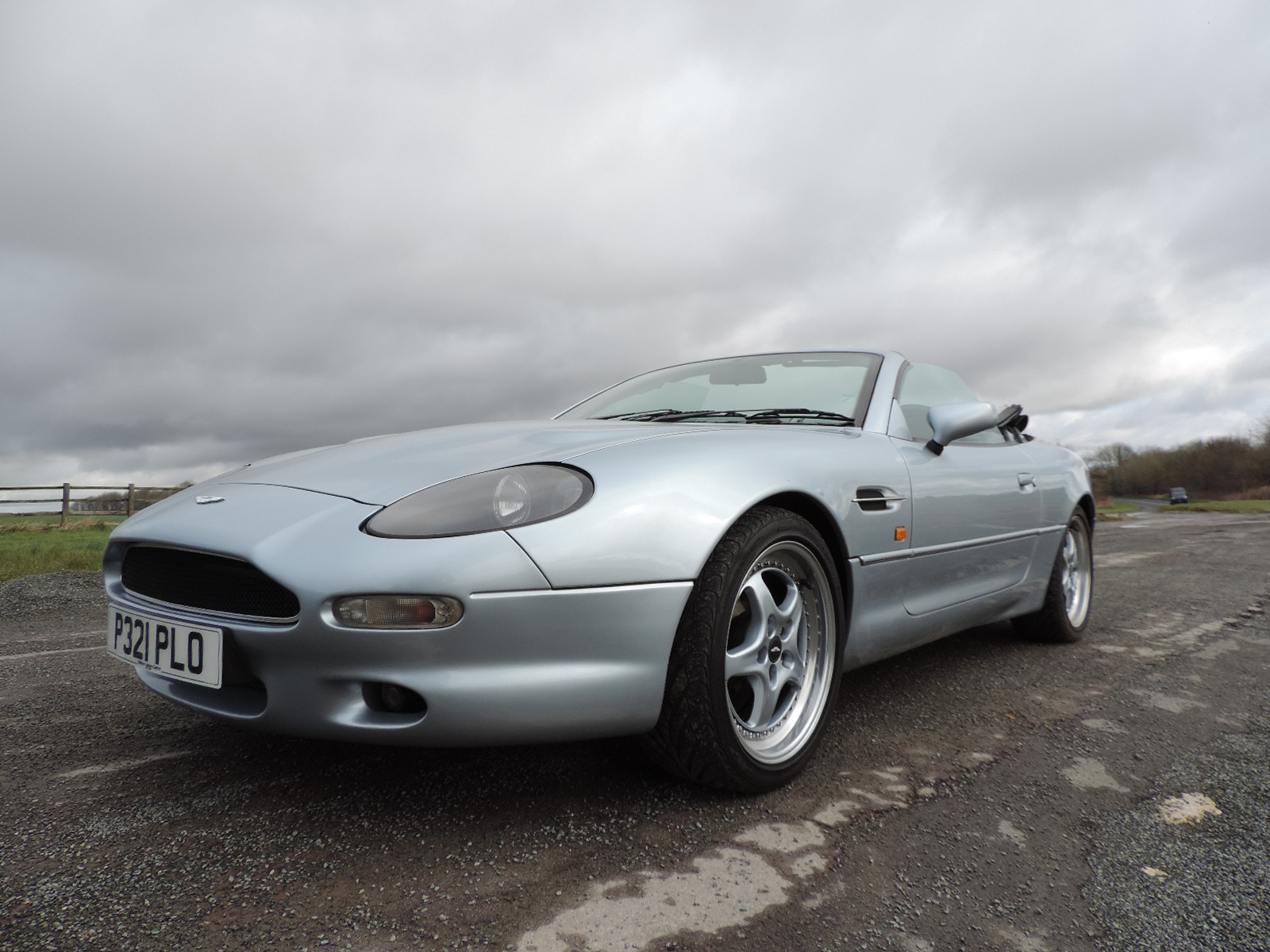
Bill Woodhouse provides his own unique insight into the inner workings of Aston Martin during the David Brown era where it seems life wasn’t all about making cars for James Bond films.
The end of one era…
It has seldom been recorded why there was such a fundamental change of direction of the policies of the by now merged Lagonda and Aston Martin during the David Brown era in the early 1960s.
The merger itself was not without friction. Claude Hill had designed a superb 2 litre push rod engine for the post war Aston Martin and this had more than proved itself in the hands of St John Horsfall by winning the Spa 24 hour race in 1947. When David Brown acquired the company then shortly afterwards Lagonda he decided to standardise on the W.O. Bentley inspired twin overhead cam straight six engine. Impressive though the specification may sound consider these points; why fit a cast iron block with wet liners? Why give a six cylinder engine only four main bearings? Why design for a barrel crank that has to incorporate cheeses? Why drive the water pump by the gear train so a lump of ice in the pump will strip the gear train? And so on and so on. Claude Hill was so incensed by this decision that he made a drawing to show David Brown as to how the new proposed DB2 bonnet would have to be more bulbous and ugly to incorporate this Lagonda engine and resigned.
Claude Hill joined Harry Ferguson and was instrumental in launching the Ferguson system and the “Little Grey Fergie” that knocked a big hole in David Brown tractor sales. Later Claude developed the Ferguson four wheel drive revolution, first adopted by Jensen and then Range Rover.
Notwithstanding this set back David Brown’s enthusiasm and hands on knowledge took Aston Martin to ever greater competition heights. What is not well known is that David Brown, whilst working his apprenticeship, started to build his own car from scrap including grinding the cam shaft to his own design. When his father found out he stopped the project instantly as wasting time and company resources. As is well known Aston Martin became World Sports Car Champions, adding huge prestige and invaluable advertising to the whole Corporation encompassing amongst others gear boxes, especially marine, foundry, railway running stock, heavy fabrication and not least tractors.

Then came the Chancellor of the Exchequer who decreed that a company making losses could not offset these losses against another company making profits for tax purposes. David Brown Corporation argued that for tax purposes their Automotive Division of tractors and cars were for tax purposes one company. After several years in which the lawyers waxed fat the final court ruling was against David Brown Corporation and in favour of the Inland Revenue.
All this happened to coincide with Ford Motor Company deciding to raise their profile through competition. They approached both Ferrari and Aston Martin with offers to buy and chose Ferrari. Enzo Ferrari was at the point of signing when the telephone rang. It was Agnelli of Fiat telling him he did not have the authority. Both Fiat and the state had the controlling share and he was not to sign. A white faced Enzo tore up the contract in front of the shaken Ford top brass.
On learning this David Brown sent John Wyer to Deerborn to sell Aston Martin. We now have two conflicting stories. David Brown’s is John Wyer sold himself instead of Aston Martin. John’s is he soon discovered Ford had decided not to buy another company but to set up their own Competition Department and would he like to run it? Whatever the truth Ford Advanced Vehicles were set up at Slough under John Wyer and we all know the Ford GT40s eventual competition success.
On top of all this turmoil the long lease at Hanworth Airpark, whose large hanger had been home to both Aston Martin during the David Brown era and beforehand between the war years was due for renewal at a great increase in rent. David Brown had already bought the Tickford Coach works and premises at Newport Pagnell and additional land across the road. It made commercial sense to move Aston Martin to Newport Pagnell where Tickfords were already producing bodies to a much higher standard than the previous suppliers. It is at this point I was asked to join Aston Martin during the David Brown era and so begins a new chapter.
The beginning of the next…
With the decision made to not renew the lease on the large hanger at Hanworth Airpark in Feltham but to relocate all operations, other than chassis production, to Newport Pagnell Aston Martin found they had a severe personnel problem. Quite simply key members of staff were not prepared to move to Newport Pagnell. For several generations they had either lived near Feltham, if working for Aston Martin, or down the road in Slough if Lagonda and new people had to be recruited urgently and I was one of them.
Just as my recruitment to ICI was through what would now be called nepotism so it was with AML. One of my widowed Aunts had married a dashing, good looking General in the early 1950s. His twin brother on retirement in the early 1960s, also a General, had become David Brown’s Personal Assistant. He knew that having been forced, through lack of working capital, to sell Tornado Cars to Johnny Beckaert, I was a free agent.

He asked me if I would come and help out the problems at AML to which I agreed. The offer was to be the Senior Development Engineer. This involved a long meeting with Tadek Marek who was now head of the Development Department. Tadek was the engine designer who produced the straight six engine that launched the DB4. My memories of this long interview were drawings all around his office of various configurations of a V8 engine with multitudes of camshaft option, which I longed to discuss with him. He on the other hand wanted to quiz me on the potential of reinforced plastic bodies. My advice at the end was to continue with the “Superleggaria” licenced aluminium bodies for current production but seriously consider GRP for any future model and my expertise would be available.
My next interview was with Steve Heggie up at Newport Pagnell. Steve really did epitomise the new Era. He had been appointed as the new Managing Director by “Black Jack” Thomson as he had made Tractor Division Parts Department a financial success and had attended the Harvard Business School of Management. Steve had no empathy with performance cars whatsoever. Apparently he had never driven anything more exciting than his company issue Hillman before his AML appointment.
“Black Jack” was so named not only for his dark appearance but for his ruthlessness. David Brown had recruited him whilst he was Purchasing Director for the Ford Motor Company but before he had told Ford of his decision to leave he had a nasty accident on his son’s motorbike. A car out of a side road hit him and seriously damaged his leg. Ford not only fought his case against the driver but paid for his medical care. Once discharged from hospital he then told Ford he was leaving them to join David Brown to head up the DB Corporation.

Steve Heggie wanted to see all the accounts of Tornado Cars and was somewhat depreciating at the small percentage of profit we made each year, not forgetting we paid financial backers 15% per annum. When I subsequently learnt that AML had made a whopping loss for years on every car sold I thought this was a bit rich, but I was given the job as Senior Development Engineer.
I then thought I must give myself a rapid introduction to these cars and what better way than owning one? From the top of a London ‘bus I spotted a blue DB2 in a showroom. Getting off at the next stop I went back to look at this cabriolet with an asking price of £500. The very nice young man who owned the showroom said it is reputed to have been David Brown’s personal car but many claim that, although I have a feeling it may be true. I was running an A35 van at the time that I had fitted with rear windows and rear seats, also valued at £500, so we did a straight swap.
When I duly reported to Feltham on my first day at the start of 1963, having parked; the front door opened and George, David Brown’s chauffeur, came out and stopped in amazement. “Good Lord,” he said, “Fancy seeing that again. I took the ‘old man’ down to the South of France many times in that!”. I then also discovered it was the only DB2 to be factory fitted with a 3 litre engine, in fact the prototype for DB to test to his satisfaction. I’ve learnt recently that it has resurfaced again this time in Australia and is coming back to the UK for a complete restoration by which time it will be valued at a quarter of a million.
However I digress. The atmosphere at Feltham was now pretty poisonous. John Wyer and Reg Parnell and other senior management were still in charge serving out their severance terms but, as far as I could see, recruiting key staff to join them at the embryo Ford Advance Vehicle Project at Slough. Perhaps naturally they had no love for those of us recruited to replace them. I was asked if I would agree to be the Senior Service Engineer rather than Development Engineer as they were so desperately short of service personnel. Being such a new boy I agreed but with hindsight regret relinquishing what would have been my input to future models and AML development which I would have tried to take down a very different route.
Nevertheless the service side was full of interest; planning and building with a clean sheet of paper a new Service Depot on a green field site. I did though become very concerned that we were going to lose so many experienced key personnel and telephoned my mentor, General Adam Block, to this effect. He in turn persuaded David Brown to offer every assistance in relocating families and generous terms for key personnel to work for a six month hand over period at Newport Pagnell. As a result of this the change of venue ended up as a relatively smooth and trouble free hand over with every emphasis now to make the operation profitable rather than loss making – not that Production ever managed this but we did on the Service side.
———
That’s our view now share yours. Simply add your feedback below, or tell us what else you would like to see featured using the Online Form
Also did you know that by simply pressing the Facebook Like or Google+ buttons below, it not only lets your friends know you like something, it also makes it easier for them to find as well.
Aston Martin during the David Brown Era – Aston Martin during the David Brown Era – Aston Martin during the David Brown Era – Aston Martin during the David Brown Era – Aston Martin during the David Brown Era – Aston Martin during the David Brown Era – Aston Martin during the David Brown Era – Aston Martin during the David Brown Era – Aston Martin during the David Brown Era – Aston Martin during the David Brown Era – Aston Martin during the David Brown Era – Aston Martin during the David Brown Era




Hi , I found an old photograph of my father and a team of David Brown workers ( possibility 1950’s ) they are standing behind an Aston Martin which they all worked on my brother thinks it won Le Mann’s my brother is 77 , I am 74 , is there any way of finding out please , the car has a number on the side with a man sitting inside . My Fathers name was Walter Hill , he was a sheet metal worker . If not can you put me in touch with a website that can help , thanking you in anticipation, regards Suzanne
My father was Edward Craske. He was one of the key workers that couldn’t make the move. I believe he was manager at Feltham at the time. He apprenticed with Lagonda and joined Aston Martin when it was taken over. I remember the Christmas children’s parties. Visit to the circus and pantomimes. Dad would tell me to be on my best behaviour when David Brown said hello. Dad fitted the machine gun to the DB5, easy for him as he was ground crew during the war. Dad was a very quiet man but he did after dinner speeches for the Aston Martin club and knew some of the members.